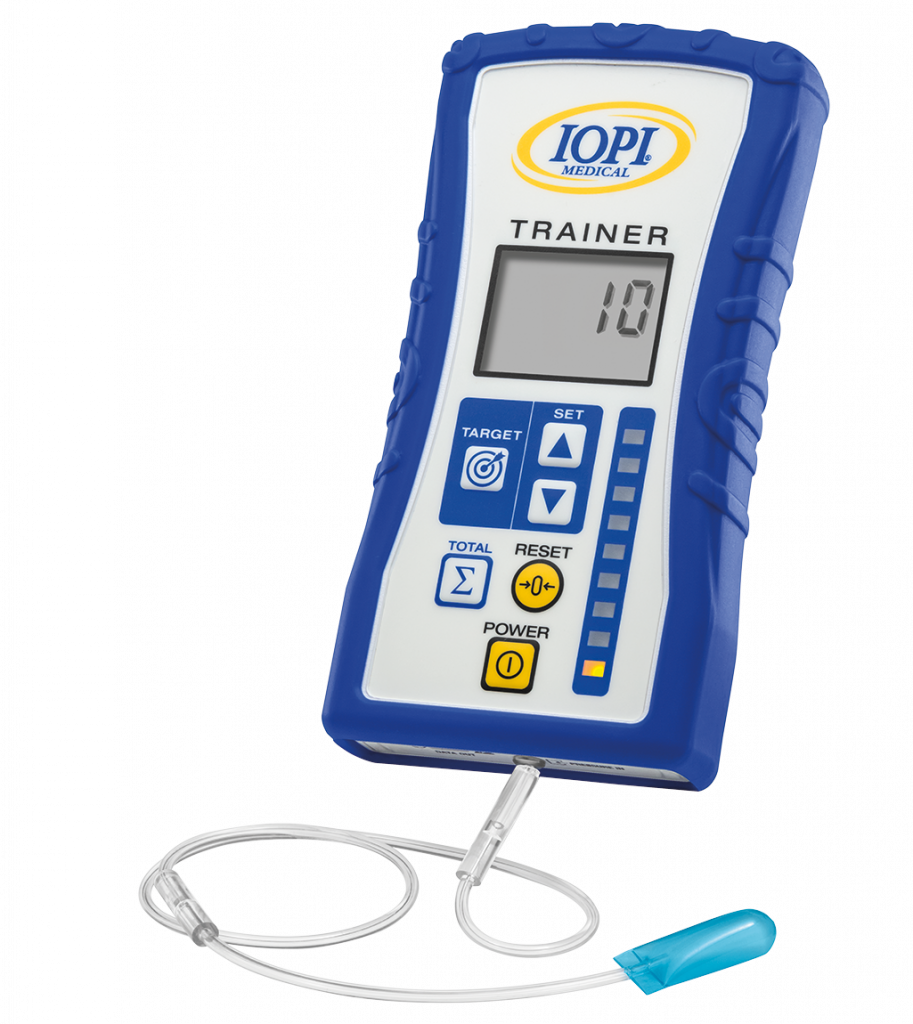PATIENTS
DO YOU OR A LOVED ONE HAVE A PROBLEM SWALLOWING?
This condition is called dysphagia. IOPI Medical products are often used with patients that have this condition.
What is an IOPI?
An Iowa Oral Performance Instrument (IOPI) is used by clinicians to measure your tongue and lip strength and determine whether exercise for these muscles may be useful for you. Clinicians typically use the IOPI Pro. This device measures your maximum strength as well as provide biofeedback for exercises in the clinic.
The IOPI Trainer was designed specifically for you to perform your tongue or lip exercises at home with biofeedback. The lights on the IOPI Trainer help make sure you are exercising hard enough to increase strength over time.
Your clinician will program your IOPI Trainer for you. All you have to do is turn it on and start your exercises! The device automatically records all activity, giving your clinician the ability to see if you exercised as instructed.
ABOUT DYSPHAGIA
Definition • Causes • Prevalence • Diagnosis • Treatment
What Is Dysphagia?
Dysphagia means difficulty swallowing. It can occur in several ways:
- Oral dysphagia can be difficulty chewing and moving food into the throat.
- Pharyngeal dysphagia can mean difficulty starting the swallow, squeezing food through the throat, and difficulties with preventing food from entering the airway.
- Esophageal dysphagia can be due to poor relaxing and tightening of the openings that allow food to pass into the esophagus and stomach. It can also be due to problems with how the esophagus squeezes

What Causes Dysphagia
Some causes are due to damage to the nervous system and the brain. These include:
Stroke
Parkinson’s disease
Alzheimer’s disease
Brain injury
Amyotrophic lateral sclerosis (ALS)
Cerebral palsy
Multiple sclerosis
Dysphagia is also associated with head and neck cancer as well as injuries or surgeries involving the head and neck.

How Common is Dysphagia?
One in 25 adults in the United States will experience some type of dysphagia each year2. Because dysphagia is associated with many disease processes and age groups a true prevalence is not really known. Here are some dysphagia statistics:
- May occur in 22% of adults age 50 and older7
- As high as 68% of nursing home residents14
- Up to 38% of independently residing adults12
- As high as 78% of patients following a stroke 8
- 50% of patients with head and neck cancer5
- 13% to 57% of patients with dementia 1
- As high as 90% in people with Parkinson’s disease 4
How is Dyphagia Diagnosed?
Modified Barium Swallow Study (MBSS): The patient swallows small amounts of barium and foods covered with barium, which can be seen in X-ray video. The test allows a clinician to examine how the food travels from the mouth, through the throat, and into the esophagus. The study can reveal problems with the efficiency of the swallow as well as determine if food or liquid is entering the airway. The information obtained is used to diagnose a problem and to develop a treatment plan.
Fiberoptic Endoscopic Evaluation of Swallowing (FEES): A very small camera is placed in the throat by the clinician and the patient swallows liquids and foods. The clinician analyzes the information to determine if there are swallowing problems. The information obtained is used to diagnose a problem and to develop a treatment plan.
How is Dysphagia Treated?
If you are diagnosed with dysphagia your doctor may refer you to a therapist, in the US this is most commonly a Speech-Language Pathologist. The therapist will work with the patient and caregivers to develop a plan for treatment. Some common approaches include exercise and teaching techniques that may help compensate for specific swallowing problems. In severe cases the doctor may recommend diet changes or even a feeding tube.

HOW CAN USING AN IOPI HELP?
Because every swallowing problem is unique, no one approach to treatment helps everyone. There is research to indicate that, when properly administered, the IOPI can help with the following swallowing issues by:
- Decreasing penetration and/or aspiration (food and liquid going into the airway)11,13
- Decreasing food remaining in the mouth after the swallow11
- Improving overall oral phase of swallowing3,6,9
- Improving overall pharyngeal phase of swallowing3,6,9
- Improving swallowing timing11
- Decreasing residue in the throat after swallowing11,14
- Improving tongue strength6,9,11
- Improving swallow pressure9,10,11
- Improving diet11
- Improving quality of life11

Ready to purchase? Get started with a quote!
If you would like information about how IOPI can help, enter the information below. Please include your clinician's contact information if you would also like them to receive a copy. Additional questions or request for assistance? Let us know! We are happy to assist you via email, a phone call, or a video conference.
FREQUENTLY ASKED QUESTIONS
REFERENCES
1. Alagiakrishnan, K., Bhanji, R. A., & Kurian, M. (2013). Evaluation and management of oropharyngeal dysphagia in different types of dementia: a systematic review. Arch Gerontol Geriatr, 56(1), 1-9.
2. Bhattacharyya, N. (2014). The prevalence of dysphagia among adults in the United States. Otolaryngol Head Neck Surg, 151(5), 765-769.
3. Cho, Y. S., Oh, D. H., Paik, Y. R., Lee, J. H., & Park, J. S. (2017). Effects of bedside self-exercise on oropharyngeal swallowing function in stroke patients with dysphagia: a pilot study. J Phys Ther Sci, 29(10), 1815-1816.
4. Coates, C., & Bakheit, A. M. (1997). Dysphagia in Parkinson's disease. Eur Neurol, 38(1), 49-52.
5. Garcia-Peris, P., Paron, L., Velasco, C., de la Cuerda, C., Camblor, M., Breton, I., et al. (2007). Long-term prevalence of oropharyngeal dysphagia in head and neck cancer patients: Impact on quality of life. Clin Nutr, 26(6), 710-717.
6. Kim, H. D., Choi, J. B., Yoo, S. J., Chang, M. Y., Lee, S. W., & Park, J. S. (2017). Tongue to palate resistance training improves tongue strength and oropharyngeal swallowing function in subacute stroke survivors with dysphagia. J Oral Rehabil, 44(1):59–64.
7. Lindgren, S., & Janzon, L. (1991). Prevalence of swallowing complaints and clinical findings among 50-79-year-old men and women in an urban population. Dysphagia, 6(4), 187-192.
8. Martino, R., Foley, N., Bhogal, S., Diamant, N., Speechley, M., & Teasell, R. (2005). Dysphagia after stroke: incidence, diagnosis, and pulmonary complications. Stroke, 36(12), 2756-2763.
9. Park, J. S., Kim, H. J., & Oh, D. H. (2015). Effect of tongue strength training using the Iowa Oral Performance Instrument in stroke patients with dysphagia. J Phys Ther Sci, 27(12), 3631-3634.
10. Robbins, J., Gangnon, R. E., Theis, S. M., Kays, S. A., Hewitt, A. L., & Hind, J. A. (2005). The effects of lingual exercise on swallowing in older adults. J Am Geriatr Soc, 53(9), 1483-1489.
11. Robbins, J., Kays, S. A., Gangnon, R. E., Hind, J. A., Hewitt, A. L., Gentry, L. R., et al. (2007). The effects of lingual exercise in stroke patients with dysphagia. Arch Phys Med Rehabil, 88(2), 150-158.
12. Serra-Prat, M., Hinojosa, G., Lopez, D., Juan, M., Fabre, E., Voss, D. S., et al. (2011). Prevalence of oropharyngeal dysphagia and impaired safety and efficacy of swallow in independently living older persons. J Am Geriatr Soc, 59(1), 186-187.
13. Steele, C. M., Bailey, G. L., Polacco, R. E., Hori, S. F., Molfenter, S. M., Oshalla, M., et al. (2013). Outcomes of tongue-pressure strength and accuracy training for dysphagia following acquired brain injury. Int J Speech Lang Pathol, 15(5), 492-502.
14. Steele, C. M., Greenwood, C., Ens, I., Robertson, C., & Seidman-Carlson, R. (1997). Mealtime difficulties in a home for the aged: not just dysphagia. Dysphagia, 12(1), 43-50; discussion 51.



